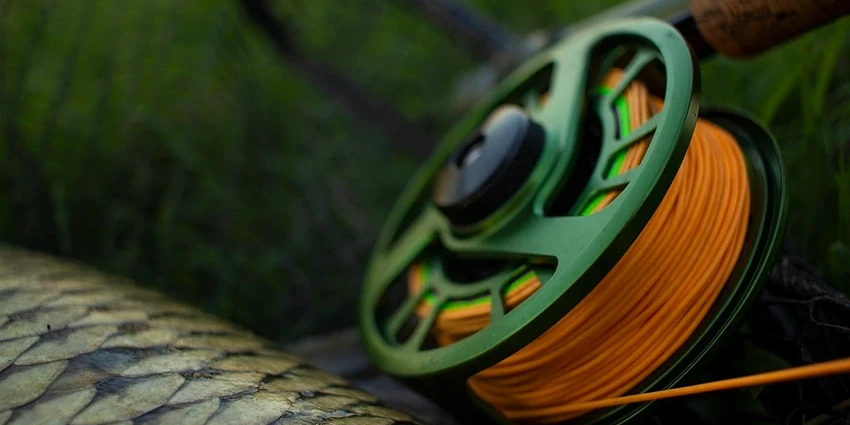All products were chosen independently by our editorial team. This review contains affiliate links and we may receive a commission for purchases made. Please read our affiliates FAQ page to find out more.
Winter bass fishing might not be the first thing that comes to mind when the temperature drops, but it’s a hidden gem for anglers who are willing to brave the cold. Bass fishing techniques in the winter require a unique approach, and if you’re looking to up your fishing game during the colder months, you’ve come to the right place.
Now, let’s dive into the world of winter bass fishing and explore the strategies and tips that will help you reel in those elusive bass even when the mercury drops.
Jump to:
Understanding Winter Bass Behavior
In the winter, bass tend to slow down and become less active. They are cold-blooded creatures, and their metabolism decreases as water temperatures drop. This means you need to adjust your tactics accordingly.
Table 1: Bass Behavior in Winter
| Water Temperature | Bass Activity |
| Below 50°F | Sluggish |
| 50-55°F | Somewhat Active |
| 55-60°F | Moderately Active |
| 60°F and above | Active |
As you can see, understanding the water temperature is essential. When the temperature drops below 50°F, bass become sluggish, making them less likely to chase fast-moving baits. However, when the water is slightly warmer, they become more active and willing to strike.

Essential Gear for Winter Bass Fishing
To conquer winter bass fishing, you’ll need the right gear. Here’s a list of essential equipment to ensure a successful outing.
Table 2: Essential Winter Bass Fishing Gear
| Equipment | Description |
| Medium to Heavy Rod | Provides the strength to handle larger bass. |
| Baitcasting Reel | Offers better control for precise casts. |
| Fluorocarbon Line | Low visibility and sinks, ideal for cold water. |
| Warm Clothing | Layer up to stay warm and comfortable. |
| Quality Boots | Keep your feet dry and warm. |
Selecting the Right Lures
Choosing the right lures is critical for winter bass fishing. Bass are less active during this season, so opt for lures that mimic their natural prey. Here are some effective options.
Table 3: Recommended Winter Bass Fishing Lures
| Lure Type | Description |
| Jigs | Slow and subtle movement, great for cold water. |
| Jerkbaits | Mimic injured baitfish, enticing strikes. |
| Soft Plastics | Lifelike and versatile, perfect for finesse. |
| Crankbaits | Diving lures that cover different depths. |
Finding the Ideal Fishing Spots
Location is everything in fishing, and the same holds true for winter bass fishing. Bass tend to gather in specific areas during the colder months.
Table 4: Ideal Winter Bass Fishing Spots
| Fishing Spot | Description |
| Deep Water | Bass move to deeper areas for warmer water. |
| Sunlit Shallows | Shallow areas that warm up during the day. |
| Docks and Piers | Provide structure and shelter for bass. |
| Rock Structures | Attract bass seeking warmth and cover. |
Weather Considerations
Weather plays a significant role in winter bass fishing. Pay attention to weather forecasts and plan your trips accordingly.
Table 5: Weather Impact on Winter Bass Fishing
| Weather Condition | Bass Activity |
| Sunny Days | Bass may become slightly more active. |
| Cloudy Days | Often preferred by bass, offering more cover. |
| Windy Days | Stir up the water, increasing bass activity. |
| Precipitation | Can make fishing uncomfortable but not impossible. |
As you can see, understanding how weather conditions affect bass behavior can help you plan your trips more effectively.

Tips for Safe and Comfortable Fishing
Fishing in cold weather requires additional precautions to ensure your safety and comfort.
- Dress in Layers: Wear thermal clothing and waterproof outer layers to stay warm and dry.
- Hand Warmers: Keep hand warmers in your pockets to combat numb fingers.
- Hot Beverages: Bring a thermos of hot coffee or tea to stay warm from the inside out.
- Stay Dry: Invest in quality rain gear to keep dry during unexpected showers.
By following these tips, you can ensure an enjoyable and productive winter bass fishing experience.
Register for our latest in-depth reviews and product round-ups from the experts
Enter your email address below to receive our twice monthly reviews emails.
By entering your details, you are agreeing to our terms and conditions and privacy policy. You can unsubscribe at any time.
Reading Water and Understanding Structure
To consistently catch bass in the winter, it’s essential to understand how to read the water and identify underwater structures where bass might be hiding. Take a look at the table below to get a better grasp of this crucial aspect of winter bass fishing.
Table 6: Reading Water and Identifying Structure
| Water Features | Bass Locations |
| Drop-offs | Bass often hang out near drop-offs, especially those close to deep water. |
| Underwater Grass | Bass seek shelter in submerged grass, which provides warmth and cover. |
| Rocks and Boulders | These structures attract bass looking for warmth and ambush points. |
By learning to identify these features, you can improve your chances of finding and catching bass in the winter.
Slow and Steady Retrieval
During the winter, bass are less active and less willing to chase after fast-moving baits, similar to the challenges faced in fly fishing. For more insights on winter fishing strategies, check out our comprehensive guide on fishing apps and tools. Understanding different casting techniques, such as those detailed in our guide on fly fishing casting methods, can be beneficial in these situations. This is where a slow and steady retrieval technique comes into play. Beginners can learn more about bass fishing techniques in our beginner’s guide to bass fishing. Check out the table below for more insights into this effective method.
Table 7: Slow and Steady Retrieval Technique
| Lure Type | Retrieval Speed | Technique |
| Jigs | Slow and methodical | Bounce them along the bottom. |
| Soft Plastics | Slow and subtle | Give them a lifelike presentation. |
| Swimbaits | Slow and steady | Mimic slow-moving prey. |
Using slower retrieval speeds allows you to keep your bait in the strike zone longer, increasing your chances of enticing a bite.
Jigging for Success
Jigging is a proven technique for winter bass fishing, closely aligning with the principles outlined in our guide on winter fishing strategies. It involves lifting and dropping your bait in a way that mimics natural prey. Let’s take a closer look at how to effectively use jigging for winter bass.
Table 8: Jigging Techniques for Winter Bass Fishing
| Jig Type | Jigging Style | Tips and Tricks |
| Football Jig | Drag and hop | Mimic crawfish movements. |
| Finesse Jig | Shake and pause | Entice lethargic bass. |
| Swim Jig | Steady retrieve | Imitate injured baitfish. |
Experiment with different jig types and styles to find what works best in your fishing conditions.
Drop Shot Fishing
Drop shot fishing is another finesse technique that can produce results in cold water. This method involves suspending the bait above the bottom, enticing bass with a tantalizing presentation.
Table 9: Drop Shot Fishing Tips
| Drop Shot Setup | Bait Selection | Presentation Tips |
| Light Rod | Worm or soft bait | Keep bait slightly above bottom. |
| Thin Fluorocarbon | Small hooks | Use subtle twitches and pauses. |
| Small Weight | Natural colors | Create a lifelike movement. |
Drop shot fishing allows you to keep the bait in the strike zone without requiring aggressive movements.

Jerkbait Tactics
Jerkbaits can be highly effective for winter bass fishing. These lures imitate injured baitfish, making them irresistible to bass. Check out the table below for insights into using jerkbaits effectively.
Table 10: Jerkbait Strategies for Winter Bass Fishing
| Jerkbait Type | Twitching Technique | Tips and Tricks |
| Suspending Jerkbaits | Sharp twitches | Mimic a wounded fish. |
| Floating Jerkbaits | Subtle jerks | Pause and let it suspend. |
| Deep Diving Jerkbaits | Steady retrieve | Cover different depths. |
Jerkbaits require finesse in presentation and can be a game-changer in cold water conditions.
Soft Plastics and Finesse Rigs
Soft plastic baits are versatile and perfect for finesse fishing during the winter. They come in various shapes and sizes, allowing you to mimic different types of prey.
Table 11: Soft Plastics and Finesse Rigs
| Soft Plastic Types | Finesse Rigs | Presentation Tips |
| Worms | Texas or Carolina rig | Work them slowly along the bottom. |
| Craws | Neko rig | Use subtle movements and pauses. |
| Tubes | Wacky rig | Let them fall and twitch lightly. |
Soft plastics provide a lifelike appearance that can entice even the most cautious bass.
To explore a variety of bait options that can enhance your winter fishing experience, consider reading our article on fishing bait choices
Understanding Bass Feeding Habits
To succeed in winter bass fishing, it’s crucial to understand what bass are feeding on during the colder months. This knowledge allows you to choose the right bait and presentation.
Table 12: Winter Bass Feeding Habits
| Prey Species | Bass Diet in Winter |
| Crawfish | A staple in their diet. |
| Small Fish | Including shad and minnows. |
| Insects and Larvae | Depending on availability. |
By imitating these natural prey items, you can increase your chances of a successful winter catch.
Patience and Precision
Winter bass fishing requires patience and precision. Bass are less active, so you need to be deliberate in your approach. Cast accurately and methodically work your bait through potential bass-holding areas.
Landing and Handling Bass
Finally, when you do land a bass, it’s essential to handle it with care, especially in cold water. Use a landing net to avoid injuring the fish, and practice catch and release whenever possible to preserve bass populations.
FAQs
The best bait options include jigs, jerkbaits, soft plastics, and live bait like minnows.
Start by fishing deeper areas and gradually move shallower as the day progresses and water temperatures rise.
Water temperatures can range from the low 40s to the upper 50s, depending on your location.
Yes, live bait like minnows can be effective, especially when other baits aren’t producing results.







